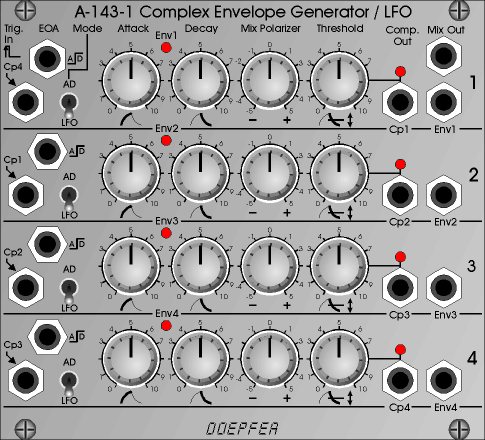



( Please contact first before visiting)






Analogue Modular System A-100















Complex Envelope Generator / LFO


The A-143-1 is a complex envelope generator with Attack/Decay generators. For a complex envelope generator the four units are daisy-chained, i.e. the preceding unit triggers the following unit. The four units can be used as four separate AD generators (switched to AD mode) or AD-type LFOs (switched to LFO mode). Each envelope can be switched into free running mode (LFO mode), unlike a normal LFO the slopes are exponential and it is the combined Attack and Decay controls that govern the LFO rate. When the envelope goes into the decay phase and reaches the Threshold level the CP1 output goes high. This is internally connected to the next envelope trigger. Each envelope is the same, until envelope 4 triggers Envelope 1. Any connection will de-normalise this signal path. Each envelope output is mixed with a polarizing mixer so can be added or subtracted from the main output. Each envelope also has a dedicated output as well.
If the trigger input of unit 1 is controlled by a normal gate signal (e.g. from a keyboard via MIDI-to-CV/Gate interface) a very complex envelope signal at the mix output is achieved.
The signal contains 8 segments controlled by Attack 1, Decay 1, Attack 2, Decay 2, Attack 3, Decay 3, Attack 4 and Decay 4. The transition between the stages (i.e. when the following AD generator is triggered) is controlled by the threshold knob. The positive or negative contribution of each unit to the mix signal is adjusted with the Mixing Polarizer control. If the trigger input of unit 1 is controlled by the comparator output of unit 4, an 8 stage LFO is generated. The single AD outputs can be used to control VCAs or VCFs that open one after another corresponding to the AD signals (a little bit similar to the Shepard generator A-191). The default-connection between the four units (CPn = Trig.n+1) can be interrupted by patching cables into the trigger inputs. Consequently the four units can be used as separate AD generators or LFOs. In any case the mix signal is available (e.g. mix of four AD generators or LFOs with adjustable level and sign). In the LFO mode the comparator output serves as LFO rectangle output with adjustable pulse width (= threshold control). Each unit is equipped with a separate LED display for envelope and comparator output.


























